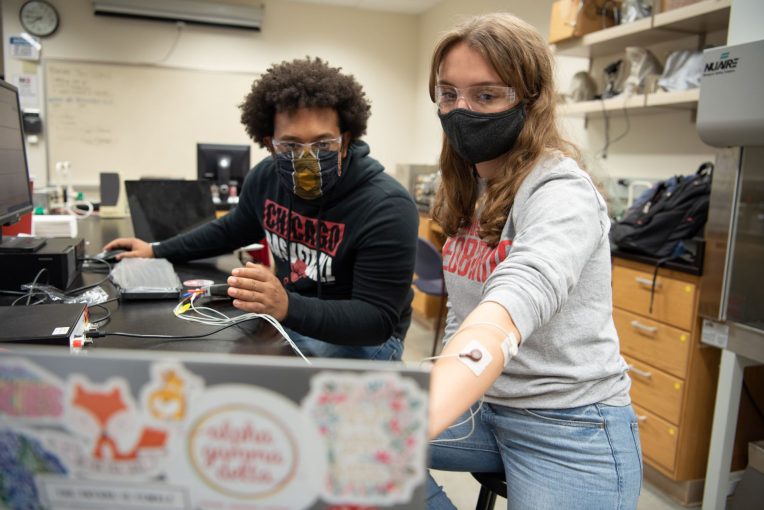In a lab designed to illustrate how living organisms operate, it only makes sense there’d be an entire week dedicated to respiration systems. In previous Biological Sciences (BSC) 283: Animal Physiology courses, students would breathe into devices themselves to measure lung capacity and simulate different chronic conditions such as asthma.
But as the Center for Disease Control (CDC) has warned the public since the beginning of the coronavirus (COVID-19) pandemic, one of the fastest ways the novel virus travels is through the air. So, naturally, that type of assignment in a lab classroom was out of the question.
Illinois State students and faculty proved once again they could pivot to make the best of the situation.
Realizing quickly the original experiment wouldn’t work, the class used crayfish instead, placing them in both low and high saline solutions. A compound called soda lime would absorb the carbon dioxide the creatures breathed out, and students then made an airtight seal on the containers so that the only opening was a tube containing a bubble of water. The resulting vacuum would pull the bubble further toward the container, creating an avenue to alternatively measure lung capacity.
Simple enough, right? Well, it still mirrored the original concept and purpose of the lab.
“It was possible to do it this way, but it definitely required some adjustments,” said graduate teaching assistant Shana Border.
While every class has been altered in some way due to safety and health protocols, lab classes that are most effective in a hands-on way have had to be extra creative.
In a night lab of BSC 283, students have had to work with each other in a hybrid format. Some are in the lab, and others are communicating via Zoom. They are paired off in groups of four, with two students on-site and the other two working virtually.
“It’s been an interesting transition, especially since half of our class is online and making sure they are able to see and learn as best as they can,” said junior molecular and cellular biology major Teague Williamson, who has been at the lab primarily in-person. “But you make adjustments to the format.”
The class has conducted experiments on muscle contractions, respiratory function, and how signals get transmitted along nerves, just to name a few. Students have used crickets, cockroaches, earth worms, computer modeling, and their own bodies to complete the tasks, all while using the hybrid format.
“The whole situation is obviously stressful, but all of my students immerse themselves into it and give it their all.”
Graduate teaching assistant Shana Border
When it was clear early on that this would be the way the class was structured, the groups quickly got together and determined roles. The two working remotely for the night would be either the note-takers or directing the experiment, while the other two would do the hands-on work.
The labs instituted a poll where every week students can rate each other as group mates. That opened up lines of communication quickly and also provided an accountability factor. While challenging, the student scientists have risen to the occasion.
“The whole situation is obviously stressful, but all of my students immerse themselves into it and give it their all,” Border said. “They always do whatever they are willing to do to make this work.
They’ve built some really strong rapports.”
Border also noted how students have been particularly proactive with safety measures, whether that’s properly distancing in the lab or making the decision to work virtually if they may have been exposed to the virus.
Dr. Wolfgang Stein teaches the course and relies on graduate teaching assistants like Border to lead the labs. It’s been a group effort to safely and effectively navigate through the course, but students and faculty have made the necessary adjustments to make their learning just as meaningful.
Apply now for 2021.

